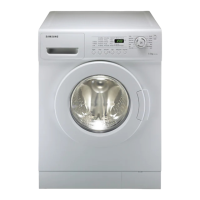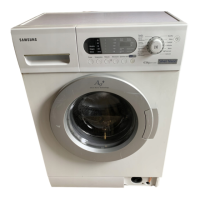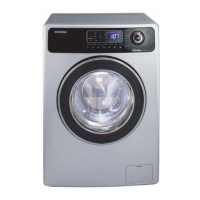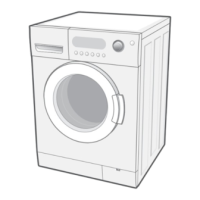Why Samsung WF-B861 Washer shows 5E error?
- KKara HillSep 9, 2025
A '5E' error on your Samsung washer suggests a drainage issue. Clean the debris filter and ensure the drainage hose is installed correctly.

Why Samsung WF-B861 Washer shows 5E error?
A '5E' error on your Samsung washer suggests a drainage issue. Clean the debris filter and ensure the drainage hose is installed correctly.
Why Samsung Washer is not draining?
If your Samsung washing machine isn't draining and/or spinning, make sure the drain hose isn't squashed or bent, and check that the water hose mesh filter isn't clogged.
What to do if my Samsung WF-B861 Washer will not start?
If your Samsung Washer isn't starting, there are a few things to check. First, ensure that the door is firmly closed. Next, verify that the washing machine is properly plugged into a working outlet. Also, make sure the water source faucet is turned on. Finally, be sure you have pressed the Start/Pause button.
What to do if my Samsung WF-B861 Washer does not drain and/or spin?
If your Samsung Washer isn't draining or spinning, check that the drain hose isn't squashed or bent, which could be obstructing the water flow. Also, make sure the water hose mesh filter is not clogged, as this can also prevent proper drainage.
How to fix 4E error on Samsung WF-B861 Washer?
To address a “4E” error on your Samsung Washer, first ensure that the source water faucet is turned on, allowing water to flow into the machine. Additionally, check the water pressure to make sure it's sufficient for the washer to operate correctly.
Why Samsung Washer shows 4E error?
The 4E error on your Samsung washer indicates a water supply issue. Make sure the source water faucet is turned on and check the water pressure.
How to fix 5E error on Samsung Washer?
To resolve a “5E” error on your Samsung Washer, start by cleaning the debris filter to remove any obstructions. Also, ensure that the drainage hose is correctly installed to facilitate proper water outflow.
How to fix LE error on Samsung WF-B861 Washer?
To fix the “LE” error on your Samsung Washer, check if the end of the drain hose is too low, ensuring the holder of the drain hose in the back is intact. Also, verify that the end of the drain hose is not submerged in water.
How to fix dE error on Samsung WF-B861?
If your Samsung washer is displaying a 'dE' error, close the door completely.
Why Samsung Washer is too noisy?
A Samsung washing machine might vibrate excessively or be too noisy because it's not set on a level surface. Adjust the washing machine feet to level the appliance. Also, ensure that the shipping bolts have been removed, the machine isn't touching any other object, and the laundry load is balanced.
Key steps before initial appliance operation for safe and proper use.
Essential safety guidelines and warnings for operation, maintenance, and potential hazards.
Instructions for unpacking and inspecting the washing machine for any shipping damage.
Diagram identifying the primary components and external features of the washing machine.
Criteria for choosing an ideal installation spot, considering stability and environment.
Procedure for leveling the appliance using adjustable feet to ensure stability.
Step-by-step guide to remove shipping bolts, crucial for preventing damage.
Instructions for correctly attaching the water supply hose to the machine and faucet.
Guidance on correct drain hose placement and height requirements for proper drainage.
Critical electrical safety information, including grounding and wiring requirements.
Explanation of control panel buttons: programs, temperature, spin, options, delay start, pause, power, child lock.
Procedure for running a preparatory wash cycle without clothes to clean the drum.
Guide on where and how to add laundry detergent, softener, and prewash detergent.
Steps for manually selecting wash programs, temperature, and spin settings without Fuzzy Logic.
Details on special wash options like 'Prewash' and 'Rinse Hold' for enhanced cleaning.
Advice on sorting, securing fasteners, and determining correct load capacity for best results.
Table showing maximum load capacities for different fabric types and washing machine models.
Recommendations for selecting and using detergents based on fabric type and wash conditions.
Procedure to safely thaw and restart a washing machine that has frozen in cold temperatures.
Instructions for cleaning the washing machine's exterior surfaces using mild detergents.
How to clean the debris filter regularly to maintain optimal drainage and operation.
Procedure for cleaning the mesh filter in the water supply hose to prevent blockages.
Common washing machine issues and their corresponding step-by-step solutions.
Explanation of displayed error messages and guidance on how to resolve them.
Checklist of troubleshooting steps to perform before contacting customer after-sales service.
Table detailing wash programs, load capacities, detergent use, temperature, and cycle times.
Descriptions of suitability for each wash program, including fabric types and soil levels.
Guide to understanding fabric care symbols for proper washing, drying, and ironing.
Critical safety precautions concerning electrical connections, grounding, and power usage.
Advice on environmentally responsible disposal and usage, including detergent and water saving.
Statement confirming compliance with relevant European safety standards and EC directives.
Detailed technical specifications, including dimensions, capacity, power consumption, and spin speeds.












